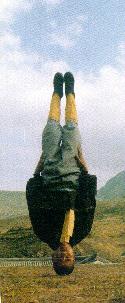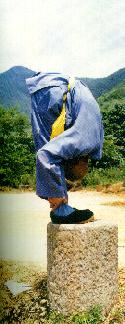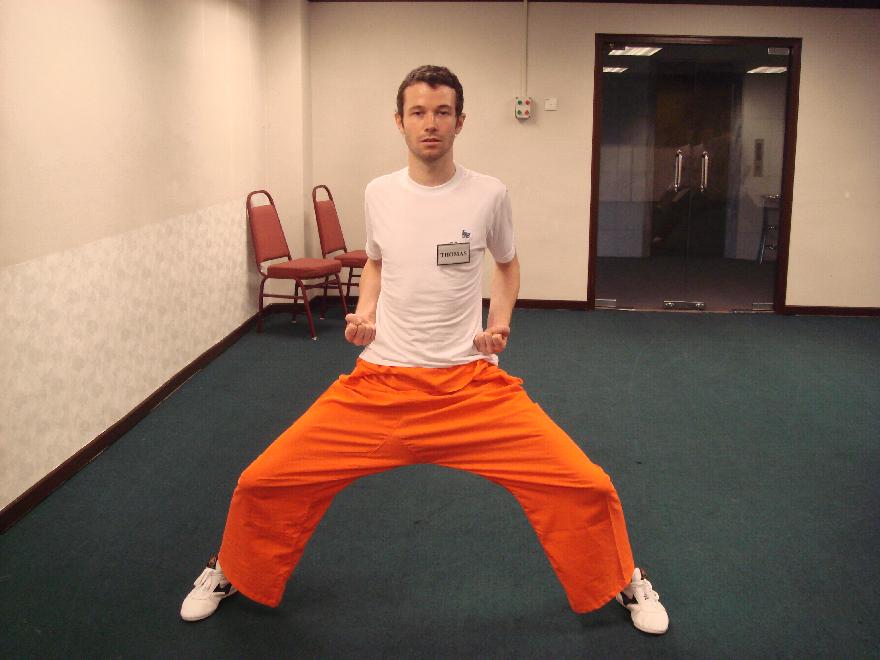May 2002 (Part 1)
SELECTION OF QUESTIONS AND ANSWERS

A Shaolin monk performing a head stand, a pattern from “Luohangong” not unlike hartha yoga
Question 1
I wish to prepare myself to excel in kung fu. I have some technical questions regarding the horse stance. On page 63 in your book, “The Art of Shaolin Kung Fu”, you recommend not to raise your body if you get tired. So what do you do after your posture-holding session is over?
— Pasha, USA
Answer
Practicing the horse-riding stance is one of the best ways to prepare yourself for excellence in kungfu. It would be better if you practice “Lifting the Sky” about 20 times before you practice the horse-riding stance.
Try not to raise your body when you are tired. When you find that you could not continue holding your posture further, raise your body and bring your feet together in the centre and drop your arms leisurely at your sides.
If you can jump to bring your feet together, it would be better. Just before your jump, bend your body slightly forward, release your fists which you have been holding at your waist and place your open palms near your knees. As you jump, breathe in gently through your nose into your chest, and simultaneously bring your open palms together facing upward at chest level. When you are standing upright with your feet together, turn your palms to face downward and lower them to your dan tian level, simultaneously breathing out through your mouth, and letting your chi sink gently — this is very important, gently — down to your dan tian. This is called “Chi Focusing at Dan Tian”. Then drop your arms leisurely at your sides.
Whether you bring your feet together in an ordinary way, or perform “Chi Focusing at Dan Tian”, remain standing upright in a totally relaxed manner with your arms hanging comfortably at your sides. Then think of nothing and do nothing for 5 to 10 minutes. This thinking of nothing and doing nothing is most important. If you relaxed sufficiently, you will find yourself swaying gently due to your internal chi flow. This is called in Shaolin Kungfu in Chinese (Cantonese pronounciation) as “Yew Foong Pai Lau”, or “Flowing Breeze and Swaying Willows”, sometimes read in classics but seldom understood by the uninitiated.
“Flowing Breeze and Swaying Willows” is one of the secrets in Shaolin Kungfu. As far as I know I am the first person to explain it in public. If you do not perform “Flowing Breeze and Swaying Tree” after horse-riding stance or any chi kung exercise, you would lose more than half the benefits. It is this “Flowing Breeze and Swaying Willows” that generate the internal force in the horse-riding training, without which it becomes merely physical exercise.
Question 2
Some instructors do their horse stances lower to the ground and with their hands outstretched at shoulder level. What's the difference between your method and theirs?
Answer
These instructors are right. We at Shaolin Wahnam also perform the horse-riding stance with our hands outstretched. We call it “Carrying Water”.
In the basic horse-riding stance, the hands are held in fists at the waist on both sides. After performing this basic mode for some time, which can be a few weeks, months or years depending on the standard aimed at, one may use alternative modes. “Carrying Water” is one of them.
Another is “Holding Ball”, which is holding your two arms in a big circle like holding a big ball in front of your chest at your horse-riding stance. The “Three-Circle Stance”, widely used in Taijiquan, probably evolved from “Holding Ball”.
Yet another is “Lifting Water”, which is stretching your two arms gently in front while at the horse-riding stance, with your palms open and fingers pointing forward. “Lifting Water” is also performed at the goat-riding stance, and is an important part of the “Golden Bell” training. Again, the Taijiquan pattern “Lifting Water” may have evolved from this stance.
The most important variation of the horse-riding stance is the “Golden Bridge”, where you are at the horse-riding stance with your two arms outstretched in front and your hands holding the One-|Finger Zen hand-form. It is the most important force training method in Southern Shaolin Kungfu.
The different modes of the horse-riding stance give special effects. The basic stance focuses energy at the dan tian as well as builds energy at the body, arms and legs. “Carrying Water” develops powerful arms. “Lifting Water” focuses at the palms. “Holding Ball” enables the energy to circulate along the arms, as well as focus at the dan tian. “Golden Bridge” consolidates the energy all over the body.
Question 3
Did the Shaolin monks practice a system similar to hatha yoga for their flexibility? How about the Taoist masters?
— Dylan, Japan
Answer
Yes, the Shaolin monks in the past practiced a system called “Luohangong” or “Lohan Art” which is not “The Eighteen Lohan Hands”, and which is similar to hartha yoga. The patterns in “Lohan Art” look very much like the patterns in hartha yoga.
Bodhidharma himself or some other early Indian Buddhist masters might have taught the early Shaolin monks hartha yoga exercise, or the “Lohan Art” and hartha yoga might have developed from a common source in India much earlier.
Although it is generally accepted that Bodhidharma taught the “Eighteen Lohan Hands”, it might be possible that this great master actually taught the “Lohan Art” or hartha yoga exercises, which later evolved into its present forms and known as “Eighteen Lohan Hands”. The present “Eighteen Lohan Hands” have much Taoist influence and are unlike hartha yoga in form, although they have similar functions. Besides flexibility, the “Eighteen Lohan Hands” also pay much attention to energy flow and internal force.
The Taoist masters also practiced flexibility exercises similar to hartha yoga, but I do not think they were evolved from hartha yoga. Unlike the Shaolin flexibility exercises which probably originated from India, the Taoist exercises were probably native exercises originating in China. These Taoist exercises are now known as “Tongzigong” or “The Art of Becoming Child-Like”.
“Tongzigong” is not only unlike hartha yoga in form, the nature of practice is also different. While the exercises in “Lohan Art” are more static, like hartha yoga exercises, Tongzigong exercises are more dynamic, like “Eighteen Lohan Hands”.

A Shaolin monk practicing a pattern from “Tongzigong” called “Embracing Buddha's Legs”
Question 4
Can you recommend any good sources of information on the Chinese equivalent to hartha yoga?
Answer
“Shaolin Luohangong” or “Shaolin Lohan Art” is the nearest equivalent to hartha yoga that I can think of. It is an important part of Shaolin Praying Mantis Kungfu, and is used to train not just flexibility but internal force. It is also found in Shaolin Lohan Kungfu. However, there is not much written about “Lohan Art”, it is usually passed down from master to students by words of mouth.
“Tongzigong” or “Art of Becoming Child-Like” is another near equivalent to hartha yoga, but as mentioned above these two arts probably developed independently and have some fine differences. While some Shaolin masters also practiced “Tongzigong”, it is generally acknowledged as a Taoist art, and was important in Wudang Kungfu. The Shaolin grandmaster, Pak Mei, who was a Taoist priest although Shaolin was generally Buddhist in tradition, was famous for “Tongzigong”. “Tongzigong” was also generally passed down by words of mouth.
In both philosophy and approach, chi kung and yoga are similar, although their methods may be different. Both disciplines start with health and vitality, then proceed to energy control, and at the highest level liberate the personal spirit to be united with the Universal Spirit. In yoga the process is from hartha yoga to pranayama to raja yoga. In chi kung the process is from dynamic chi kung exercise to quiescent breathing exercise to meditation.
Hence, in this comprehensive cultivation from the physical to energetic to spiritual, the equivalent of hartha yoga in the Indian system are dynamic chi kung patterns in the Chinese system. Dynamic chi kung patterns are known as “dao yin”. Most of chi kung practiced today is of the “dao yin” type, and some well known examples are “Eight Pieces of Brocade” and “Eighteen Lohan Hands”.
Question 5
Exactly how do you tie a kung fu sash? Do practitioners of different kung fu styles tie their sashes differently?
— Reck, USA
Answer
The main purpose of the sash is to hold your pants so that they will not fall off. So irrespective of your kngfu style, you can tie it in any suitable way you like, but usually in a “live” knot so that in case of urgency you can untie it conveniently.
One helpful way to tie the sash is as follows. After you have wound the sash round your waist one or more times, place the left end over the right and make a half reef. Then make a small loop on both sides, place the right loop over the left loop and pull tightly, with both ends of the sash dangling down. This is a “live” ribbon-like knot. You can untie the knot easily by pulling any one end.
But if you are about to engage in combat, it would be better to tie a “dead” knot, like a reef-knot, to avoid a possible embarrassing situation of your opponent getting your pants down by pulling an end of your sash. The reef knot is formed as follows. Place the left end of the sash on the right and pull tight to form a half reef, then place the right end over the left and pull tight to complete the reef knot.
If you are a student you tie the ribbon-like knot or the reff knot on the left side of your waist. If you are an assistant instructor you tie it on your right. If you are an instructor you tie it in the centre. This way of tying the knot according to rank is a common kungfu tradition, but is not universal.
Question 6
Does the color of the sash represent a rank like in karate?
Answer
No, in traditional kungfu the colour of the sash does not represent a rank. Indeed, if someone says he holds a rank of 10th dan black belt, I would suspect that his is not traditional kungfu. By convention, the sash of a novice as well as of a master is usually black in colour.

Horse-Riding Stance
Question 7
Is there any way to prevent hair loss?
— Liang. Malaysia
Answer
Practicing chi kung is a good way to prevent hair loss. But you have to practice genuine chi kung, not just some gentle physical exercise.
A crucial difference between genuine chi kung and gentle physical exercise is that chi kung works on energy whereas gentle physical exercise only works on the physical body like bones, muscles and joints. Many people think that they practice chi kung when actually they only practice gentle physical exercise.
“Carrying the Moon” is excellent for preventing or recovering from hair loss. Gently think of your head as you bend down while doing this pattern. Two other very good chi kung patterns to practice are “Lifting the Sky” and “Nourishing Kidneys”. You can find them in my chi kung books.
Question 8
What is exactly the difference between chest breathing and reversed breathing? It seems to me that reversed breathing is a deep chest breathing. You also mention in your book that reversed breathing is chest breathing. I am quite confused because other books that I have read seem to differentiate between chest breathing and reversed abdominal breathing. Could I have further explanation from Sifu to clear up my confusion?
— Roy, Indonesia
Answer
Reversed Breathing is chest breathing in the sense that the practitioner uses his chest to breath, whereas in Abdominal Breathing the practitioner breathes with his abdomen. But Reversed Breathing is not the same as the kind of chest breathing ordinary people use. Herein lies the confusion.
In ordinary chest breathing one breathes into the chest, and breathes out from the chest. During the in-breath good energy enters the lungs. During the out-breath bad energy goes out from the lungs. Hence his chest rises during breathing in, and falls during breathing out.
Abdominal Breathing is different. Instead of using the chest to breathe, one uses the abdomen. The practitioner breathes into his abdomen, and out from his abdomen. During the in-breath good energy goes into the abdomen. During the out-breath bad energy goes out from the abdomen. Hence, his abdomen rises during breathing in, and falls during breathing out.
Some clarification would be helpful here to the Western educated. To Western educated persons, breathing means taking in and giving out air. In this sense it is impossible to breathe into the abdomen, because the lungs are air-tight and air cannot get to the abdomen from the lungs.
So to them, abdominal breathing means diaphragmatic breathing, which is as follows. When one breathes in he pushes his diaphragm downward into the abdomen, causing the abdomen to rise, but the air enters the lungs and not the abdomen. When he breathes out, he pushes his diaphragm upwards to the chest, causing his abdomen to fall, and air goes out from the lungs.
In chi kung, diaphragmatic breathing is not Abdominal Breathing. And what is breathed in and out is not just air but energy. The meaning of chi (qi) is energy — long before air was discovered by modern scientists. So in Abdominal Breathing, when one breathes in, energy goes into the dan tian or energy field at the abdomen, and when one breathes out, energy goes out from the abdomen.
Reversed Breathing is the reverse of Abdominal Breathing, especially in the rise and fall of the abdomen in relation to breathing in and out. In Abdominal Breathing the abdomen rises when breathing in, and falls when breathing out. In Reversed Breathing the abdomen falls when breathing in, and rises when breathing out. This relationship is similar to that in ordinary chest breathing, but Reversed Breathing is not ordinary chest breathing.
In Reversed Breathing, when a practitioner breathes in, good energy enters his lungs from the cosmos outside, and at the same time negative energy also enters his lungs but from his abdomen. When he breathes out, the good energy which he has just taken in from the cosmos, goes down into his abdomen, and simultaneously the bad energy which just came from his abdomen, goes out from his lungs into the cosmos.
The lungs act like an exchange station through which good energy from the cosmos flows into the abdomen, and bad energy from the abdomen flows into the cosmos. Hence, Reversed Breathing is sometimes called Cosmos Breathing, enabling an exchange of energy between the cosmos and our body.
Question 9
When I do my practice sometimes I feel a bit uncomfortable on my abdomen (right side of my dantian area). Does it mean I do the breathing incorrectly, sucking in my dantian too hard, or is it because I just started my practice and it will disappear with time I have been training for about 5 months. Will it bring negative side effect on me?
Answer
It is likely that you have a deviation. Not only you sucked in your dan tian too hard, you probably forced your chi down too. The discomfort will not disappear with time; in fact it would get worse if remedial action is not taken. But don't worry; it can be overcome as follows.
Stop your Abdominal Breathing or Reversed Breathing immediately. Perform “Lifting the Sky” about 30 times per session, three sessions a day. As you perform “Lifting the Sky”, breathe in gently through your nose, and breathe out in greater volume through your mouth, but do not force your breathing out. If you feel thirsty after the session, it is an indication that you have forced your breathing. You should clear your problem in about a month.
If you know self-manifested chi movement, your recovery would be faster, in a week or two. But don't attempt it if you have not been properly trained how to perform it.
